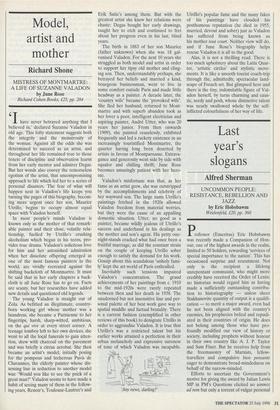Model, artist and mother
Richard Shone
MISTRESS OF MONTMARTRE: A LIFE OF SUZANNE VALADON by June Rose Richard Cohen Books, £25, pp. 284 41 have never betrayed anything that I believed in,' declared Suzanne Valadon in old age. This lofty statement suggests both the integrity and the monstrosity of the woman. Against all the odds she was determined to succeed as an artist, and throughout her life remained true to those tenets of discipline and observation learnt from her early mentor and admirer Degas. But her words also convey the remorseless egotism of the artist, that uncompromising approach to life which led her to a series of personal disasters. The fear of what will happen next in Valadon's life keeps you turning the pages of this biography, becom- ing more urgent once her son, Maurice Utrillo, begins to occupy almost equal space with Valadon herself.
In most people's minds Valadon is known only as the mother of that remark- able painter and their close, volatile rela- tionship, fuelled by Utrillo's crushing alcoholism which began in his teens, pro- vides true drama. Valadon's solicitous love for him and her astonished admiration when her dissolute offspring emerged as one of the most famous painters in the world, are vividly recreated against the shifting backcloth of Montmartre. It must be said that in her early chapters a back- cloth is all June Rose has to go on. Facts are scanty, but her researches have added new details and questioned old legends.
The young Valadon is straight out of Zola. As befitted an illegitimate, country- born working girl whose mother was a laundress, she became a Parisienne to her fingertips, harsh, sharp-witted, ambitious, on the qui vive at every street corner. A teenage tomboy left to her own devices, she went to all the local funerals to gain atten- tion, drew with charcoal on the pavement and was briefly a circus acrobat. She then became an artist's model, initially posing for the pompous and lecherous Puvis de Chavannes, the elderly painter whose dis- arming line in seduction to another model was: 'Would you like to see the prick of a great man?' Valadon seems to have made a habit of seeing many of them in the follow- ing years, Renoir's, Toulouse-Lautrec's and Erik Satie's among them. But with the greatest artist she knew her relations were chaste: Degas bought her early drawings, taught her to etch and continued to fret about her progress even in his last, blind years.
The birth in 1883 of her son Maurice (father unknown) when she was 18 gal- vanised Valadon. For the next 10 years she struggled as both model and artist in order to support her tipsy old mother and cling- ing son. Then, understandably perhaps, she betrayed her beliefs and married a kind, bourgeois businessman, went to live in some comfort outside Paris and made little headway as a painter. A decade later, the 'country wife' became the 'provoked wife'. She fled her husband, returned to Mont- martre and with superb abandon took as her lover a poor, intelligent electrician and aspiring painter, Andre Utter, who was 20 years her junior. From then onwards (1909), she painted ceaselessly, exhibited frequently and led a rackety existence in an increasingly touristified Montmartre, the quarter having long been deserted by artists in favour of Montparnasse. Extrava- gance and generosity went side by side with squalor and chilling thrift; June Rose becomes amazingly patient with her hero- ine.
Valadon's misfortune was that, as her fame as an artist grew, she was outstripped by the accomplishments and celebrity of her wayward son. The large sums Utrillo's paintings fetched in the 1920s allowed Valadon freedom from material worries, but they were the cause of an appalling domestic situation. Utter, no good as a painter, became wildly jealous of Utrillo's success and underhand in his dealings as the mother and son's agent. His petty one- night-stands cracked what had once been a fruitful marriage, as did the constant strain on the couple of keeping Utrillo sober enough to satisfy the demand for his work. Gossip about this scandalous 'unholy fami- ly' kept the art world of Paris enthralled.
Inevitably such tensions impaired Valadon's concentration. The grand achievements of her paintings from c. 1910 to the mid-1920s were rarely repeated between then and her death in 1938. The unadorned but not insensitive line and per- sonal palette of her best work gave way to spatial muddle and factual brutality. There is a current fashion (exemplified in other reviews of this book) to denigrate Utrillo in order to aggrandise Valadon. It is true that Utrillo's was a restricted talent but his earlier works attained a perfection in their urban melancholy and expressive sureness of tone of which Valadon was incapable.
'Any news, darling?' Utrillo's popular fame and the many fakes of his paintings have clouded his posthumous reputation (he died in 1955, married, devout and sober) just as Valadon has suffered from being known as his mother tout court. Neither view will do, and if June Rose's biography helps rescue Valadon it is all to the good.
Alas, it is not a thrilling read. There is too much upholstery about the Latin Quar- ter, 'artistic circles' and stylistic move- ments. It is like a smooth tourist coach-trip through the, admittedly, spectacular land- scape of French art. But glimpsed here and there is the tiny, indomitable figure of Val- adon herself, by turns charming and caus- tic, seedy and posh, whose distinctive talent was nearly swallowed whole by the self- inflicted colourfulness of her way of life.


























































 Previous page
Previous page